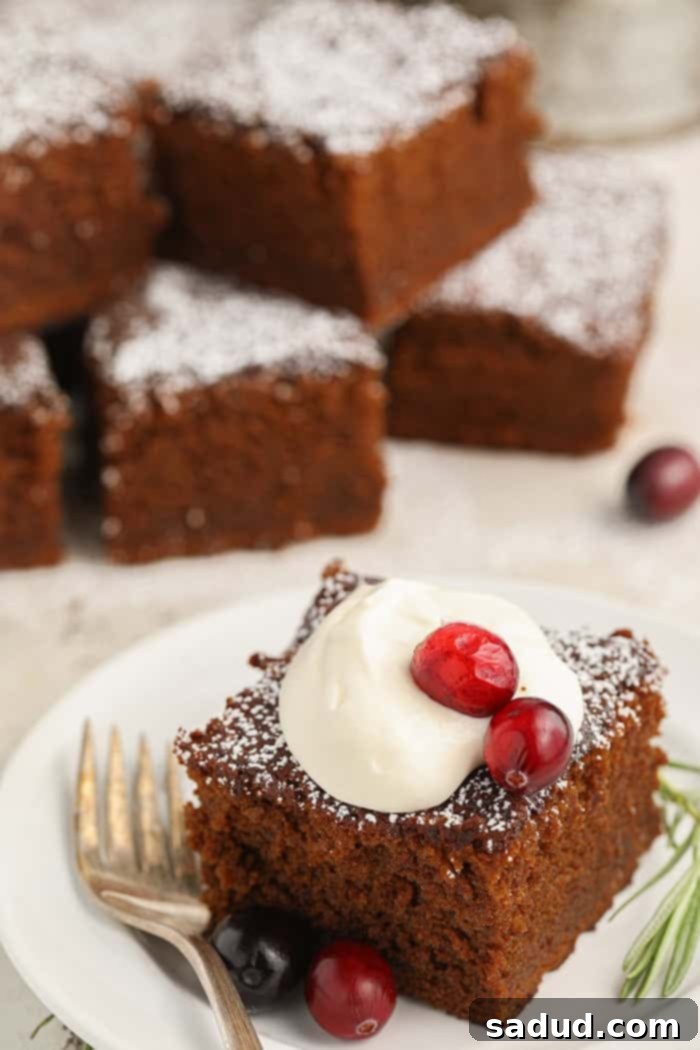Delightfully Moist & Spiced Gluten-Free Gingerbread: Your Perfect Holiday Treat
There’s nothing quite like the aroma of freshly baked gingerbread to usher in the holiday season. The warm, inviting spices evoke cherished memories and create new ones. However, for those navigating a gluten-free diet, enjoying this festive classic can sometimes be a challenge. That’s where this incredible **gluten-free gingerbread recipe** comes in. Forget dry, crumbly imitations; this gingerbread is incredibly soft, wonderfully moist, and bursting with the rich, traditional flavors you crave. Dusted with a delicate veil of powdered sugar, each bite is a journey into holiday cheer, offering all the depth and warmth of classic gingerbread, but made completely without gluten.
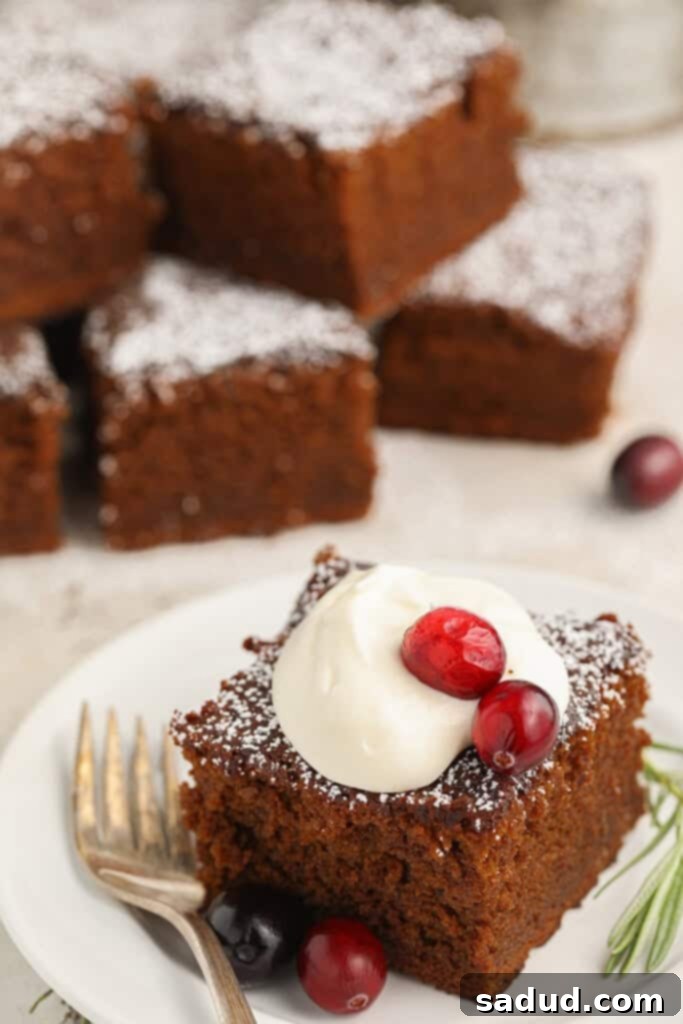
Why You’ll Adore This Gluten-Free Gingerbread Recipe
This recipe isn’t just a gluten-free alternative; it’s a showstopper in its own right, designed to impress even the most discerning palates. Here’s why this gingerbread will become your go-to holiday bake:
- Surprisingly Simple and Perfect for the Holidays: You don’t need to be a seasoned baker to achieve perfection with this recipe. It’s straightforward, making it ideal for a cozy winter afternoon baking session or for preparing a delicious treat for your holiday gatherings. The festive aroma alone will set the mood, filling your home with the essence of Christmas.
- A Symphony of Traditional Spices and Irresistible Moisture: Each bite delivers a delightful blend of authentic holiday flavors. We’ve meticulously balanced traditional spices like robust ginger, warm cinnamon, aromatic cloves, and a generous dash of rich molasses. This combination ensures a depth of flavor that is both comforting and exhilarating. The secret to its incredible texture lies in the careful ratio of wet to dry ingredients, resulting in an amazingly sweet and wonderfully moist gingerbread that melts in your mouth, never dry or dense.
- Diet-Friendly and Easily Adaptable: Crafted with gluten-free ingredients, this gingerbread is inherently vegetarian, making it accessible to a wider audience. Moreover, with just a couple of simple ingredient swaps, you can effortlessly transform this recipe into a delicious vegan treat. This flexibility makes it an excellent choice for potlucks and family meals where various dietary needs might be present. Enjoy a delicious dessert without compromising on taste or texture, suitable for almost everyone at your table.
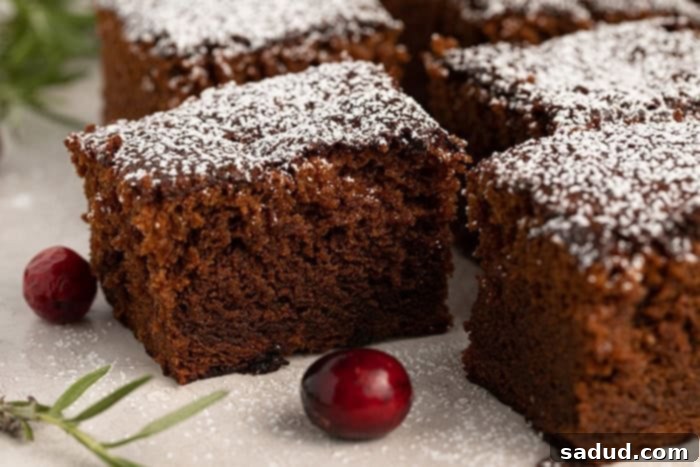
Expert Tips for Baking Your Best Gluten-Free Gingerbread
Achieving outstanding gluten-free baked goods often comes down to a few key details. These chef’s tips will ensure your gingerbread is nothing short of spectacular, mimicking the texture and flavor of its traditional counterpart:
- Xanthan Gum is Your Gluten-Free Secret Weapon: When working with gluten-free flours, xanthan gum is absolutely essential for replicating the elasticity and structure that gluten provides in traditional baking. It acts as a binder, preventing your gingerbread from becoming crumbly and giving it that desirable light and fluffy texture. Always check your gluten-free all-purpose flour blend to see if it already contains xanthan gum. Many popular brands do, and if yours does, you should omit adding extra. If your flour blend *does not* list xanthan gum as an ingredient, then you’ll definitely want to add the recommended amount. Adding too much can result in a gummy texture, so follow the recipe quantities carefully.
- Transform This Recipe into a Vegan Delight: Making this gingerbread suitable for a vegan diet is incredibly simple. For the butter, opt for your favorite high-quality vegan butter stick. Ensure it’s a brand known for its baking performance, as some vegan butters can have different fat content or melt points. For the egg, a flax egg is an excellent substitute. To make one, simply combine 1 tablespoon of ground flaxseed meal with 3 tablespoons of water, stir well, and let it sit for about 5-10 minutes until it thickens to a gel-like consistency. This flax egg will provide the necessary binding and moisture, ensuring your vegan gingerbread is just as moist and tender.
- Room Temperature Ingredients are Key: For optimal results, make sure your butter and egg are at room temperature before you start baking. Room temperature butter creams beautifully with sugar, incorporating more air and creating a lighter, fluffier batter. A cold egg can seize the butter, resulting in a lumpy mixture. If you forget to take them out in advance, you can quickly soften butter by microwaving it in 10-second intervals (be careful not to melt it!), and warm an egg by placing it in a bowl of warm water for a few minutes.
- Choose the Right Molasses for Flavor Depth: The type of molasses significantly impacts the flavor of your gingerbread. Sulphured molasses has sulfur dioxide added as a preservative, which can sometimes impart an off-flavor. Blackstrap molasses, while nutrient-rich, is the least sweet variety and has a very strong, almost bitter taste that can overpower delicate spices. For the best, most balanced gingerbread flavor and texture, always reach for light or dark unsulphured molasses. Dark unsulphured molasses will provide a stronger, more robust gingerbread flavor, while light will be milder. Either will work beautifully, depending on your preference for intensity.
- Avoid Overmixing for a Tender Crumb: While creaming butter and sugar requires thorough mixing, once you start adding the dry ingredients, it’s crucial to mix just until combined. Overmixing the batter, especially after the flour has been added, can develop the starches in gluten-free flour too much, leading to a tougher, denser gingerbread. Mix on low speed and stop as soon as no streaks of dry flour remain.
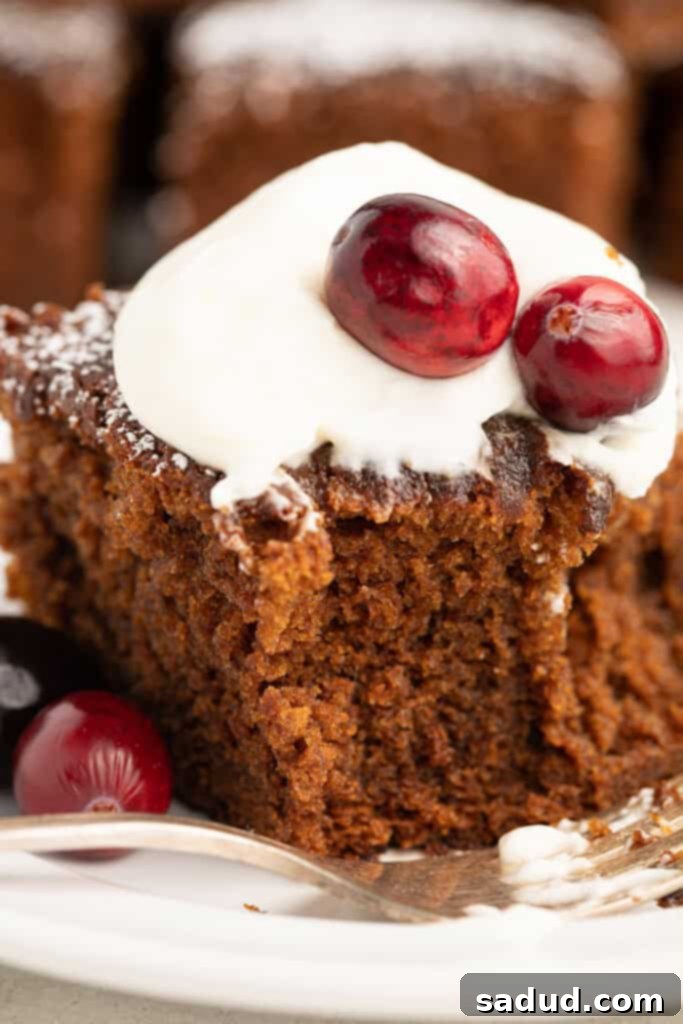
More Delicious Gluten-Free Recipes to Explore
If you’re looking to expand your gluten-free repertoire beyond this incredible gingerbread, we’ve got you covered! Explore these other fantastic recipes that prove gluten-free baking can be just as delicious and satisfying as traditional baking:
- Peanut Butter Pancakes
- Gluten Free Cornbread with Honey
- Gluten Free Stuffing
- Fluffy Gluten-Free Pancakes
Ready to bake a batch of the most incredible gluten-free gingerbread you’ve ever tasted? This recipe is simple, rewarding, and guaranteed to fill your home with the irresistible scents of the season. Follow along with the detailed instructions below to create a holiday masterpiece that everyone can enjoy!
If you loved this recipe as much as we did, don’t forget to leave us a review below. ★ Follow Easy Healthy Recipes on Pinterest, Facebook, and Instagram, too!
For more delicious recipes, visit our sister sites, 40 Aprons and Easy Cheap Recipes.
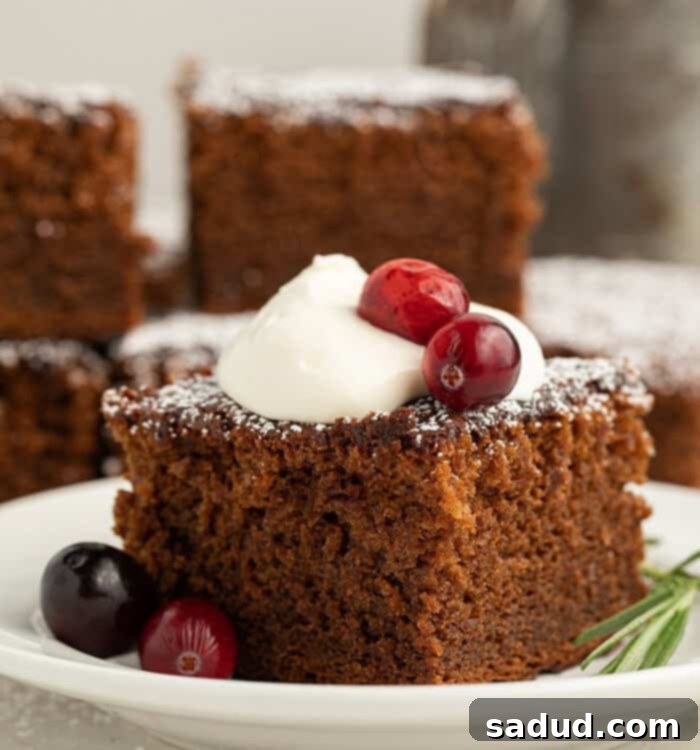
Gluten Free Gingerbread
 Cheryl Malik
Cheryl Malik
Print
SaveSaved!
Ingredients
Gathering your ingredients is the first step to baking success. Ensure all cold ingredients, like butter and egg, are at room temperature for the best mixing results.
Wet Ingredients for Gingerbread
- ½ cup butter cubed, at room temperature (or vegan butter for a dairy-free option)
- ½ packed cup brown sugar
- 1 large egg at room temperature (use 1 flax egg for vegan)
- 1 cup unsulphured molasses see Notes for best type
- 1 cup hot water water should be hot but not bubbling or boiling; helps activate baking soda and keeps gingerbread moist
- 1 teaspoon apple cider vinegar
Dry Ingredients for Gingerbread
- 2 cups gluten-free all-purpose flour see Notes, ensure it contains xanthan gum or add it separately
- ½ teaspoon xanthan gum omit if your gluten-free flour blend already contains xanthan gum
- 2 teaspoons baking soda
- 2 teaspoons ground cinnamon
- 1 ½ teaspoons ground ginger
- ¼ teaspoon ground cloves
- ½ teaspoon salt
Suggested Toppings (All Optional)
- powdered sugar for a beautiful snowy finish
- whipped cream or coconut whipped cream for vegan
- whole fresh cranberries or cherries for a pop of color and tartness
Equipment
Ensure you have these essential tools ready for a smooth baking process.
-
Oven
-
9×9 baking pan or dish
-
spray oil or butter to grease pan, ensuring easy release
-
gluten-free flour to dust pan after greasing, for an extra non-stick layer
-
stand mixer or a powerful hand mixer for creaming ingredients
-
bowl for stand mixer or a large mixing bowl suitable for vigorous mixing
-
flour sifter to ensure light, lump-free dry ingredients
-
medium mixing bowl for combining dry ingredients
-
whisk for mixing dry ingredients thoroughly
-
knife or toothpick to test doneness accurately
Instructions
Follow these step-by-step instructions carefully to bake your perfect gluten-free gingerbread. Precision in baking ensures the best results!
-
Begin by preheating your oven to 350° Fahrenheit (approximately 175° Celsius). While the oven heats, prepare your baking pan. Generously grease the bottom and sides of a 9×9 inch square baking pan with cooking spray or softened butter. This initial greasing helps prevent sticking. Next, line the pan with parchment paper, allowing the paper to hang slightly over the sides of the pan. These “handles” will be incredibly useful for easily lifting the baked gingerbread out of the pan once it’s cooled, preventing any breakage.
-
In the bowl of your stand mixer (or a large mixing bowl if using a hand mixer), add the softened butter and packed brown sugar. Begin mixing these ingredients together on a low speed for about 30 seconds to combine them initially. Then, increase the speed to medium and continue mixing for 2 to 5 minutes. The goal here is to “cream” the butter and sugar: the mixture should become noticeably lighter in color, fluffy in texture, and roughly doubled in volume as air is incorporated. A crucial note: Be mindful not to overmix at this stage, as excessive mixing can break down the emulsion, leading to a greasy or soupy consistency. If this happens, it’s best to discard and start fresh for optimal results.
-
Once your butter and sugar mixture is perfectly creamed, pause your mixer. Carefully crack the large egg directly into the mixing bowl. Resume mixing on a low speed, just until the egg is fully incorporated into the batter. This should only take about 30-60 seconds. As soon as the egg is mixed in, pause the mixer once more. Now, add the unsulphured molasses to the mixture. Turn the mixer back on to a low speed and mix until the molasses is thoroughly combined and the batter has a uniform, dark color. Pause the mixer again, and scrape down the sides of the bowl to ensure everything is well-integrated.
-
In a separate medium-sized mixing bowl, use a flour sifter to sift the gluten-free all-purpose flour. Sifting helps to aerate the flour and remove any clumps, ensuring a smoother batter and lighter gingerbread. After sifting, add the xanthan gum (only if your chosen gluten-free flour blend does not already contain it, as specified in the Notes and Tips). Then, add the baking soda, ground cinnamon, ground ginger, ground cloves, and salt to the sifted flour. Use a whisk or a fork to stir these dry ingredients together thoroughly, ensuring an even distribution of leavening and spices throughout the mixture.
-
With your mixer set to low speed, gradually incorporate the prepared dry flour mixture into the wet molasses mixture. It’s crucial to add the dry ingredients in increments, perhaps a third at a time, mixing well after each addition. Continue mixing only until the flour mixture is just combined and no dry streaks remain. Overmixing at this stage can lead to a tough gingerbread texture, as it can over-develop the starches in gluten-free flour, making it dense.
-
Once all the dry ingredients are incorporated, keep the mixer on low speed. Slowly pour in the hot water and apple cider vinegar. Continue to mix gently until these liquids are fully combined into the batter. The hot water helps to activate the baking soda and keeps the gingerbread wonderfully moist, while the vinegar reacts with the baking soda to create lift and tenderness. The batter will be quite fluid at this point.
-
Carefully transfer the prepared gingerbread batter into your greased and parchment-lined 9×9 inch baking pan. Gently spread the batter evenly to all corners of the pan. Place the pan in the center rack of your preheated oven and bake, uncovered, for approximately 40 minutes. After 40 minutes, it’s time to check for doneness: insert a clean knife or a wooden toothpick into the very center of the gingerbread. If it comes out clean or with only a few moist crumbs attached, your gingerbread is perfectly baked. If it’s still wet, return the pan to the oven and continue baking, checking every 5 minutes, until it tests done.
-
Once the gingerbread is fully baked and passes the doneness test, carefully remove the hot pan from the oven. Place it on a wire cooling rack and allow the gingerbread to cool in the pan for 10 to 15 minutes. This cooling period is important as it allows the gingerbread to set and firm up, making it easier to handle. For best results, allow it to cool completely in the pan if time permits. Once cooled enough to handle, use the parchment paper “handles” to carefully lift the gingerbread out of the pan and transfer it to the cooling rack to finish cooling if needed.
-
If you desire, add a beautiful, snowy finish to your gingerbread by using a sifter to dust the top generously with powdered sugar. This not only enhances its appearance but also adds a touch of sweetness. Then, using a sharp knife, slice the gingerbread into 9 even squares. Serve these delightful squares as they are, or with optional toppings like a dollop of fresh whipped cream (or coconut whipped cream for vegan guests), and a scattering of whole fresh cranberries or cherries for a vibrant pop of color and tart counterpoint. Enjoy this warm, spiced treat with a cup of coffee or tea!
Notes
- Gluten-Free Flour Selection: The success of this recipe hinges on your choice of gluten-free all-purpose flour blend. It is absolutely critical that your chosen blend contains xanthan gum, or that you add it separately as instructed. Xanthan gum provides the structure and elasticity typically found in gluten, preventing your gingerbread from being dry or crumbly. If your blend already lists xanthan gum as an ingredient, please do not add any more, as too much can result in a gummy or rubbery texture. Always double-check your flour’s ingredient list!
- Molasses Matters: The type of molasses significantly impacts the gingerbread’s flavor profile. Sulphured molasses contains sulfur dioxide as a preservative, which can sometimes impart an undesirable chemical taste. Blackstrap molasses, while robust, is very strong and less sweet, often tasting bitter in baking. For the most authentic and delicious gingerbread flavor and texture, we strongly recommend using either light or dark unsulphured molasses. Dark unsulphured molasses will yield a deeper, more intense gingerbread flavor, while light unsulphured molasses will provide a milder, sweeter taste. Choose according to your preference for intensity.
- Making it Vegan: Adapting this recipe for a vegan diet is straightforward. For the butter, simply substitute an equal amount of your preferred high-quality vegan butter stick. Ensure it’s a brand suitable for baking. To replace the egg, use a flax egg: combine 1 tablespoon of ground flaxseed meal with 3 tablespoons of water. Stir well and let it sit for about 5-10 minutes until it develops a gel-like consistency. This flax egg will act as an effective binder and moisture provider.
- Storage and Shelf Life: This gluten-free gingerbread stays wonderfully moist for several days. Store it in an airtight container at room temperature for up to 3-4 days to maintain its freshness and soft texture. For longer storage, you can refrigerate it for up to a week, though it’s best enjoyed at room temperature.
- Freezing Instructions: Gingerbread freezes beautifully! Once completely cooled, wrap individual slices or the entire slab tightly in plastic wrap, then an additional layer of aluminum foil. Freeze for up to 3 months. To serve, thaw overnight in the refrigerator, then bring to room temperature before enjoying. You can also gently warm individual slices in the microwave for a few seconds.
- Serving Suggestions: Beyond a simple dusting of powdered sugar, consider serving your gingerbread with a scoop of vanilla ice cream, a generous dollop of cream cheese frosting, or a drizzle of warm caramel sauce. The classic combination with whipped cream and fresh berries (cranberries, raspberries, or cherries) is always a hit, adding a bright contrast to the rich, spiced cake.
Nutrition Information
Number of total servings shown is approximate. Actual number of servings will depend on your preferred portion sizes.
Nutritional values shown are general guidelines and reflect information for 1 serving using the ingredients listed, not including any optional ingredients. Actual macros may vary slightly depending on specific brands and types of ingredients used.
To determine the weight of one serving, prepare the recipe as instructed. Weigh the finished recipe, then divide the weight of the finished recipe (not including the weight of the container the food is in) by the desired number of servings. Result will be the weight of one serving.
We hope this gluten-free gingerbread becomes a new holiday tradition in your home. Its rich flavors and tender, moist texture truly embody the spirit of the season, ensuring that everyone can enjoy a slice of festive delight, free from gluten but full of joy. Happy baking, and happy holidays!
